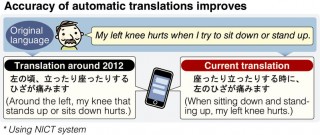Loading
Search
▼ Better Automatic Translations Sought By 2020
- Category:Event
The government plans to accelerate the development of automatic voice translation technology that instantly translates spoken words into other languages ahead of the 2020 Tokyo Olympics and Paralympics.
Demand for translation has been growing due to a rapid increase in the number of foreign visitors to Japan. The government will spend a total of about ¥10 billion over five years from fiscal 2015 to develop the technology, and promote the efforts by involving both the public and private sectors.
It is possible that “omotenashi” hospitality could be realized through automatic translation machines by around 2020.
If you say “Please form a single line,” in Japanese through a megaphone-type automatic translation device now being developed by Panasonic Corp., synthesized sounds translated into such languages as English and Chinese come out its speaker.
It is effective for giving instructions at places where many random foreigners gather, such as stations or sightseeing areas. The device was used to provide evacuation guidance at a disaster drill conducted by the Tokyo metropolitan government earlier this month.
Japan is said to conduct some of the most advanced research in the world on automatic translation, partly because many Japanese people are not skilled at foreign languages. Ahead of 2020, the government plans to develop automatic translation technologies between Japanese and nine languages including English, Chinese and Spanish.
In Japan, automatic translation research is led by the National Institute of Information and Communications Technology (NICT), which is a national research and development agency. The NICT won first place in the world competition for speech recognition technology, which determines the accuracy of translation, for three consecutive years through 2014.
The agency is working to raise the level of automatic translation by sharing its know-how with private companies such as Panasonic.
Mitsubishi Electric Corp. has developed an application to enable complex communications. For example, if a foreigner draws a picture of souvenirs that they want to buy on a tablet screen, a Japanese person who sees it can draw directions to a place where the souvenirs are available or orally convey the directions through voice translation.
The number of Japanese words that can be recognized by NICT’s automatic translation system has increased to more than 800,000 from about 60,000 in 2010.
- September 27, 2016
- Comment (0)
- Trackback(0)


